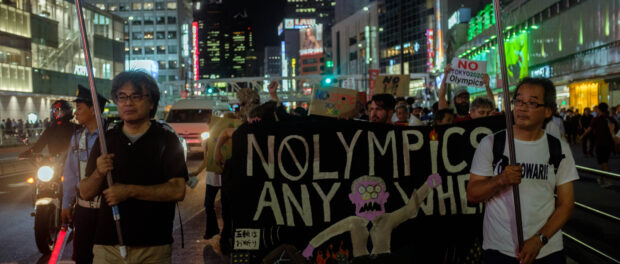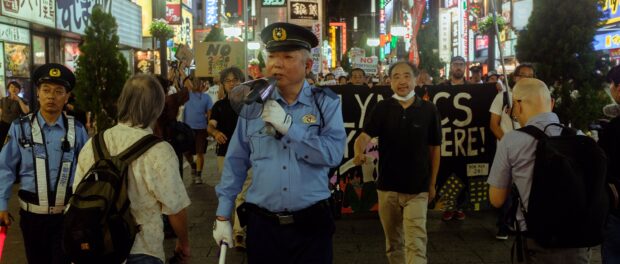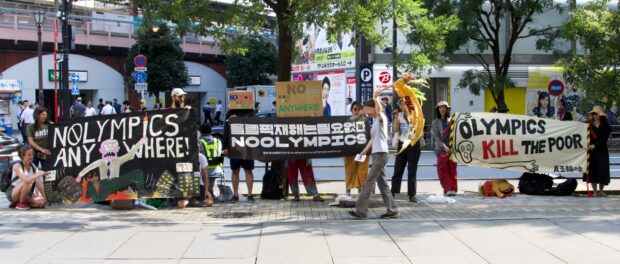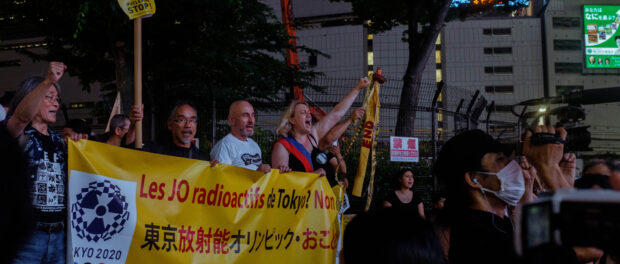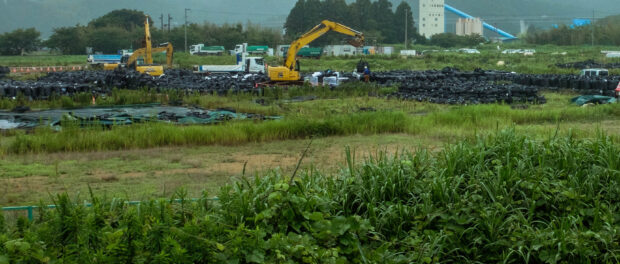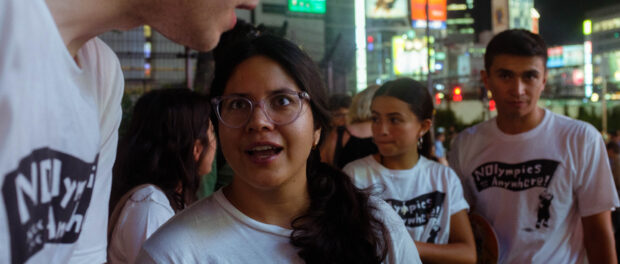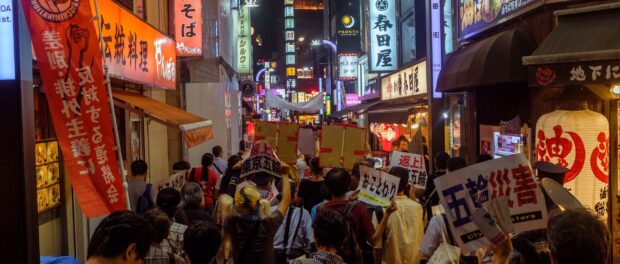
Tens of thousands of Tokyo residents heard the drumline. Tens of thousands saw the jubilant parade of hundreds of banner-bearing protesters. And tens of thousands heard the chants rejecting the Olympic Games, not just in Tokyo, Japan, but in Rio, in Pyeongchang, in Paris, in Los Angeles, and indeed, anywhere.
It was Wednesday, July 24 in the teeming district of Shinjuku, Tokyo, the summer evening air sizzling with energy. And for the transnational anti-Olympics movement, the moment was historic—not just for the legions of passers-by exposed to the critical message but for the unprecedented transnational nature of the march. Organized by the Tokyo-based collective Hangorin no Kai (‘the Anti-Olympic Group’), the protest featured representatives from NOlympics LA (LA 2028), NON aux JO2024 à Paris (Paris 2024), the Anti Pyeongchang Olympic Alliance (Pyeongchang 2018), the Popular Committee on the World Cup and Olympics (Rio 2016), and the Counter Olympics Network (London 2012). There were also participants from Seoul and Jakarta, two cities that are considering bids for the 2032 Games.
“It was a wonderful, magnificent experience that I’d never had before,” Hangorin no Kai organizer Misako Ichimura reflected. “We have done protests in Shinjuku before, but this time there were so many people watching and turning their heads. And there were so many participants. We were able to show how many people are here and how many international people have come in support.”
A tree from Mount Gariwang makes a cameo appearance. A shoutout to the fact that a 500-year-old sacred forest was chopped down to make way for an Olympic ski run for the 2018 Pyeongchang Games. #NOlympicsAnywhere pic.twitter.com/z7tyaXj0pf
— Jules Boykoff (@JulesBoykoff) July 24, 2019
Chants throughout the march called for the end of the International Olympic Committee (IOC) and Japanese Olympic Committee, as well as denouncing the Olympics in each participating city. A host of police officers accompanied the demonstration the whole way, with some in uniform corralling the marchers within the designated path and another group in dress shirts scribbling away on notepads as they followed the crowd.
The participating groups share a common critique of the Olympics, which they argue accelerate real estate speculation and displacement, incentivize militarization and the further criminalization of marginalized communities, exacerbate—and then greenwash—environmental destruction, and prioritize spectacular investment projects over local residents’ needs. Central to the movement’s analysis is the perception that the Olympics act as a vehicle for powerful actors, from nationalistic politicians to profit-hungry corporations, to extract wealth and consolidate power at the expense of host cities’ populations.
The array of banners marching down Shinjuku’s boulevards and alleyways pointed to several key critiques of the Tokyo Games. Hangorin no Kai’s “Olympics kill the poor” banner refers to trends at all Olympic Games, but in the context of Tokyo, it speaks to the displacement of public housing and unhoused residents. Tokyo’s government has ramped up sweeps targeting those who live on the streets, especially near the National Stadium—which has been entirely rebuilt ahead of 2020—and in parks around the city. The Kasumigaoka public housing complex was demolished to make way for the new National Stadium, although the eventual stadium design meant the space where the apartments once stood now remains empty.
This story may remind Rio residents of pre-Olympic removals and demolitions like those in Vila Autódromo and Favela do Metrô, where vacant space also marks the former locations of homes. And just as Altair Guimarães’ eviction from Vila Autódromo was his third eviction at the hands of the government, two women forced out of the Kasumigaoka apartments were experiencing eviction for the second time. Their first? For Tokyo’s 1964 Olympics. Speaking about the Kasumigaoka apartments, one of them told The Nation: “I thought that would be my final home. That I would die in that house. But they forced me to move. [The city] uprooted my community. Again.”
Another banner, this one wielded by organizer Frédéric Viale and mayoral candidate Danielle Simmonet from Paris, declared “No to the radioactive Olympics in Tokyo.” Officials have framed the 2020 Olympics as the “reconstruction games” in reference to the recovery effort following the 2011 nuclear disaster in Fukushima.
This framing, however, erases the still-grave reality of Fukushima’s coastal towns and residents. Some 140,000 people were evacuated in 2011 and many more left voluntarily. Less than half of evacuees have returned. Mostly elderly, they have found ghost towns, a landscape littered with mountains of black garbage bags of contaminated materials, and the persistent stress of uncertainty about lingering health risks. In contrast, many evacuees with families have no plans to return.
The Japanese government has been slowly cutting off relocation and housing assistance to evacuees with the justification that Fukushima has completely recovered, disregarding the new lives these families have tried to build elsewhere and dismissing concerns about radiation. As such, critics such as local council member Masumi Kowata have denounced the reconstruction narratives. Kowata insisted they are distracting from the real needs of her constituents. For Tokyo’s 1964 Olympics, she recalled, “I was 8 or 9. I was excited.” But the 2020 Games are being mobilized against the interests of Fukushima residents, she said. “I’m not excited.” In her view, the so-called reconstruction games are doing nothing good for her community.
Several Olympic softball games and one baseball game will take place in the region of Fukushima, but at sports venues located hours west of any previously evacuated areas. Diverting tourists and journalists from the affected areas may allow the Olympics to sustain the myth of recovery. That said, the 2020 torch relay will begin in the heart of the affected areas at Fukushima’s J-Village soccer venue, presenting an opportunity for protests to disrupt the spectacle.
On Wednesday, as protesters filled the streets beneath the glaring lights of Shinjuku’s giant billboards, social media networks lit up with transnational solidarity. Residents of Vila Autódromo filmed a message in support of Tokyo communities facing displacement, with long-time resident and anti-eviction champion Maria da Penha calling on Japanese authorities to “respect the right to housing,” saying, “our land was made to be shared, not to be sold.” Using the hashtag #NOlympicsAnywhere, organizers from Hamburg, Seoul, Los Angeles, and Long Beach (California) documented their own local actions, while numerous other cities contributed posts denouncing the Olympics.
So they sent us a message of solidarity.
🚫🚫🚫
🚫🚫@museu_remocoes pic.twitter.com/a73i1Pi0nU— NOlympics LA (@NOlympicsLA) July 24, 2019
Added to a press conference, a week-long series of educational and strategic meetings among organizers, and transnational social media buzz, the protest has generated significant media attention. Earlier in the week, Tokyo-based organizers and media activists had discussed the difficulty of attracting sympathetic or even mildly critical media coverage about the Olympics. But with multiple reports on the protest published in national and international publications, Ichimura concluded proudly: “It was us who turned the opinion of the media.”
Now, the challenge is to harness the march’s energy, channeling the knowledge that exists among the diverse anti-Olympics groups into a lasting and effective transnational alliance, one that does not just fight against the Olympics but fights for community power around the world.
Cerianne Robertson is a participant in NOlympics LA. Photos are by Los Angeles organizers Justin Gaar and Jun Ampig.

